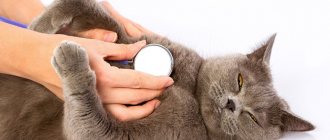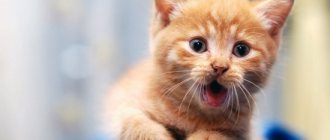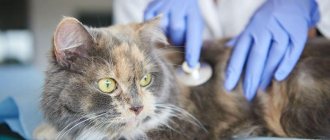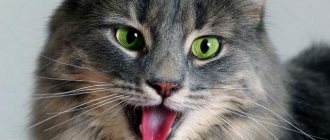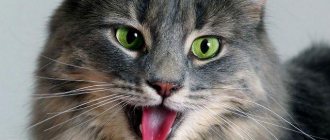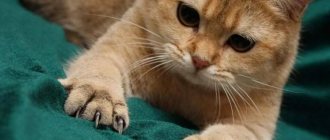The main marker of a cat's health is the animal's activity, and its breathing pattern is the second most important indicator of a cat's well-being. Violation of the usual rhythm of inhalation and exhalation for a particular pet becomes the basis for an emergency visit to the veterinarian.
Let's find out why cats' breathing becomes frequent or heavy, and what to do in such cases.
Rapid breathing as a variant of the physiological norm
A healthy cat inhales and exhales air silently. The system of supplying the animal's body with oxygen works imperceptibly; outwardly this is manifested only in uniform movements of the chest muscles.
Most adult healthy cats take approximately 30 breaths per minute, this amount corresponds to the norm - 20-40 times. The respiratory rate of kittens is slightly higher. It is about 50 breaths in 60 seconds.
What causes a healthy cat to breathe quickly?
Most often, this state of the pet is accompanied by an increased emotional background. There are many reasons that cause rapid breathing in a healthy cat.
Among them:
- unexpected fear;
- overexcitement;
- stress;
- dehydration;
- active games;
- meeting a dog;
- overheat;
- labor, prenatal period;
- excited state during mating.
Difficulty or rapid breathing in such situations is considered normal. After some time, the cat’s rhythm of inhalation and exhalation evens out, she calms down and begins to breathe as always.
Why does a kitten breathe quickly when sleeping?
Kittens, like all babies, are more mobile than adult animals. This is associated with their accelerated metabolism, increased reflexes, and rapid breathing rhythm. When a cat often breathes from his stomach after active games, this is considered normal, but if he is not eating well, you should take a closer look at the baby.
Inexperienced owners do not always understand what to do if the kitten is breathing very quickly. First of all, you need to evaluate the animal’s appearance, behavior, and breathing patterns. If the kitten meows hoarsely or wheezes, and mucus comes out of the animal’s nose, the baby needs treatment.
Some kitten owners worry when their pet breathes strangely in its sleep. In such a situation there is no need to worry. Cats see dreams and react to them in the same way as to real events. Very rarely do they sleep without dreams. Frequent breathing during sleep is a sign of emotional distress.
When should you worry?
If you notice that the cat is inhaling air suspiciously often, while he may open his mouth slightly and stick out his tongue, then measures should be taken and a qualified specialist will help in this situation. Most likely, the furry will be diagnosed with pathological processes in the respiratory organs. It is possible that the diagnosis will reveal a disease that is not directly related to the respiratory system.
Feline health problems that lead to rapid breathing:
- Diseases of the throat and trachea (edema, paralysis, collapse, oncology, etc.).
- Pathological processes in the bronchi (helminthic infestations, bronchitis, asthma). Then the pet will additionally have a dry cough and fever.
- Pathologies of the nose in cats (inflammatory processes, infections). When a purr, along with rapid breathing, wheezing and discharge from the nose are observed.
- Lung diseases (blockage due to a large number of worms, oncology, edema, inflammation).
- Abundance of air in the chest.
- Hernias in the diaphragm.
- Neoplasms in the breast with changes in the diameter of the lymph nodes.
- Heart problems (any heart failure, arrhythmias).
- Intoxication.
- Diseases of the endocrine system, hormonal imbalances.
- Anemia.
- State of shock.
- Fever.
- Dehydration or severe overheating.
If, in addition to rapid breathing, you find that your beloved cat has begun to behave suspiciously, his temperature has risen, shortness of breath has appeared and his heart rate has increased, you can hear wheezing in the chest and there is discharge from the mouth and nose, there is paleness or redness of the mucous membranes, then without hesitation, take the mustache to the veterinary clinic for diagnostics.
Pathological causes of tachypnea
Sometimes a cat breathes heavily because it is sick. The number of breaths per minute increases noticeably, the mouth is open, the sides rise and fall heavily. The cat seems to be short of air. In some cases this is what happens. For example, when a furry pet develops asthma.
Pathological causes of rapid breathing in a cat can be:
- blood diseases;
- ascites (excess fluid in the abdominal cavity);
- development of various myalgia (heart pathologies);
- airway spasm;
- lung diseases;
- increased pressure inside the abdominal cavity;
- foreign object inside the respiratory tract, trachea or bronchi;
- malignant neoplasms;
- painful growth of some organs.
Important! If a cat has difficulty breathing, only a specialist can determine the exact cause of the animal’s strange condition. Self-diagnosis is usually wrong. This results in the loss of valuable time for treating the pet.
If there is a suspicion that a cat has developed a respiratory pathology, experts advise paying attention to the appearance of the animal. If your cat's ears are flattened, he is overexcited, attacks or tries to hide, he may be under stress.
A frightened or irritated cat almost always breathes from its belly. But as soon as he calms down, breathing returns to normal. There is no need to treat such an animal.
Risk group
There are cat breeds that are prone to breathing problems. These animals were bred using multi-level selection, focusing on the most beautiful appearance. The result was a phenotype with characteristic features of the skull shape. This negatively affected the internal structure of some organs of the respiratory system. Such cats were called brachycephalic.
Persian, Himalayan, British, exotic and Scottish cats have wide muzzles, a characteristic nose shape, the larynx, trachea and jaw of animals are disproportionate to the length of the tongue. This combination is called brachycephalic syndrome (BAOS).
If your cat is brachycephalic, you need to handle him especially carefully, making sure that the animal does not overheat or become physically overtired. Such cats were unlucky from birth: their narrowed nasal openings are not able to ensure normal breathing. To inhale, animals exert certain efforts, which cause an even greater narrowing of the lumens of the nostrils. The airways are pulled inward.
Difficulty inhaling leads to stretching of the animal's laryngeal mucosa. The trachea of brachycephals is initially narrowed, and the palate is longer than that of an ordinary cat. All this negatively affects the functioning of the lungs and increases the load on the heart.
Moments of tension, sometimes even ordinary games, cause sniffling, bubbling in the chest, and coughing in brachycephalic pets. It is impossible to miss such symptoms. They signal the onset of the disease. This is the case when physical abnormalities sooner or later lead to illness.
Important! If a cat develops characteristic breathing difficulties, you should immediately take your pet to a veterinarian. Delay in the visit causes an increase in negative symptoms in the animal.
Respiratory system diseases
When a cat breathes from its belly, there are signs that its lungs are not receiving enough oxygen. The cause may be an infectious-inflammatory disease of the respiratory tract.
As a rule, furry pets get sick:
- rhinitis;
- tracheitis;
- bronchitis.
The cat's body actively fights infectious agents. Mucus is secreted, which contains many leukocytes. This is a normal reaction of the animal's immune system. However, mucus in the respiratory tract interferes with the normal process of obtaining oxygen, so the cat (or kitten) often breathes from its stomach.
A sick pet coughs and mucus comes out of its nose. As a rule, this is accompanied by high fever and an unpleasant odor from the patient’s mouth. The kitten is lethargic and suffers from diarrhea and vomiting. Ulcers form on the oral mucosa. A sick animal begins to wheeze and wheeze when breathing, cough, and sneeze.
Important! If the kitten is breathing heavily and its condition does not return to normal within a few hours, a visit to the veterinarian is required.
Non-infectious causes
It happens that a cat is breathing heavily due to an illness that is not associated with infection. For example, these could be problems with the soft palate or larynx (spasm, swelling).
Abdominal breathing syndrome is caused by the following pathologies:
- helminthiases;
- accumulation of fluid inside the chest cavity (hydrothorax);
- hiatal hernia;
- accumulation of air in the chest cavity (pneumothorax);
- inflammation of the sinuses.
Important! If, a few days after the operation, the cat continues to have difficulty breathing, the animal suffers from shortness of breath, it is necessary to urgently call a doctor. It would also be a good idea to check the condition of your pet’s gums, lips and nose. A bluish tint to the surfaces indicates the development of complications in the heart or respiratory system.
Diseases that are not associated with pathologies of the respiratory system
If a cat has damage to the spine, sternum or ribs, he will have difficulty standing up and try not to strain his chest by breathing. An injured animal breathes shallowly (through the stomach). He develops shortness of breath.
In this state, the cat does not allow you to touch the sore spots, meows loudly, and sometimes loses consciousness. He should be taken to the clinic urgently. Most injuries can only be treated with surgery.
Myalgia
Some cat breeds are predisposed from birth to developing cardiovascular pathologies. These are Maine Coons, British and Persian pets. But other members of the cat family often suffer from heart disease.
The first symptom of the development of myalgia in a cat is abdominal breathing. Then wheezing appears, the skin on the body turns pale, and the mucous membranes in the mouth become blue.
The cat is lethargic, does not eat anything, lies constantly, and breathes heavily. The animal quickly weakens, its heart beats strongly even in the absence of physical activity.
Important! If your cat is diagnosed with heart failure, you will need to give her an injection of a prescribed drug when an attack occurs. Then take it out into the fresh air.
The owner of a cat suffering from myalgia must be prepared to provide emergency assistance if breathing stops during an attack. Vigorously blowing air into the nose through cupped palms will help.
The effectiveness of assistance will increase if artificial respiration is alternated with chest compressions. But it’s best to have the doctor’s phone number handy.
Overheating
Sometimes the cat pant frequently due to the heat. If immediate action is not taken, the animal may suffer from heatstroke. Signs of overheating are:
- Temperature more than 40 degrees.
- Reddened mucous membranes.
- Rapid pulse.
- Predominantly recumbent position of the animal, the cat lies, breathes heavily, sticks out its tongue.
The amount of sweat that is secreted by the skin of a furry pet is unable to cool its body to normal temperature. To reduce body temperature, the cat opens its mouth and breathes heavily. For cats of exotic breeds, British, Scottish, Persian cats, an acceleration of the breathing rhythm in hot weather is considered normal.
Oncology
The clinical picture of this disease depends on the degree of development of the pathology, its type and location. Signs of the disease are:
- loss of appetite;
- decreased physical activity;
- increasing sleep time;
- weight loss.
A sick cat develops shortness of breath and its fur loses its shine. As the tumor grows, the animal wheezes and coughs more and more.
How to provide first aid?
If there is reason to suspect that the cat has choked and is therefore breathing frequently, you need to spread its jaws as wide as possible and, holding its mouth open, try to pull out the foreign body with your fingers or tweezers. It happens that such actions are unsuccessful due to too deep penetration of a foreign object into the larynx.
In such cases, the cat is lifted by the hind legs and held upside down. At the same time, they compress the stomach, pressing on the diaphragm with sharp thrusts. Most likely, the foreign body will pop out and the pet will be able to breathe normally.
A cat also needs emergency help if the change in breathing is associated with a heart attack, which can be determined by the accompanying symptoms.:
- cyanosis of the mucous membrane;
- pale skin;
- rapid or, conversely, slow pulse.
You should act as quickly as possible, without waiting for a critical condition. When the animal’s diagnosis is already known, it is injected with the drug prescribed by the doctor and taken out into the fresh air. If the condition is so serious that the pet has stopped breathing, you need to take basic resuscitation measures :
- lay the cat on a flat surface, fixing its body so that the spine from neck to tail is straightened;
- clear your mouth of mucus;
- hold the mouth with one hand and roll the other into a tube, through which you breathe directly into the pet’s nose approximately once every two to three seconds (in the case of kittens, the breathing rate is halved);
- perform an indirect cardiac massage if the pulse cannot be felt.
In most cases, after stopping breathing, a cat can be saved within 10-15 minutes. When the resuscitated animal begins to breathe normally, you should definitely take it to a veterinary clinic.
© shutterstock
Associated symptoms
When a cat is brought to the doctor, first of all he asks about the signs that alerted the owner of the animal. Therefore, monitoring a presumably sick pet before visiting the clinic is very important. This helps to quickly make a diagnosis.
Signs that accompany the development of pathology of the respiratory system are:
- poor appetite;
- wheezing when breathing;
- increased heart rate;
- elevated temperature;
- rapid pulse;
- redness or bluish tint of the mucous membranes;
- vomit;
- swelling;
- diarrhea;
- the appearance of mucous discharge from the mouth or nasal openings.
The effectiveness of treatment for your pet depends on the amount of time that has passed since the onset of alarming symptoms. There are diseases that develop very quickly. For example, pulmonary edema. Delay in such cases can cost the pet’s life.
What should an owner do if a cat is breathing frequently?
The owner of the animal should first determine the nature of the causes of tachypnea. To do this, you need to compare the condition, appearance and behavior of the pet. Based on observations, we can draw a conclusion about the physiological or pathological causes of the animal’s condition.
In the first case (active games, stress), you should simply give the cat time to restore its normal breathing rhythm. Conditions are created for the animal's peace and comfort. For example, if a cat overheats, be sure to give it something to drink and cool the areas of large vessels (armpits, belly, paw pads).
If you suspect a pathology, you should carefully examine the animal, check the integrity of the ribs and limbs. If an injury is detected, you need to quickly take the cat to the doctor.
A veterinarian’s consultation and treatment will be needed in any case if the animal’s condition does not improve within 3 hours, and the cat’s heavy breathing is accompanied by pathological symptoms. If tachypnea persists without physical exertion, overheating or stress, the animal must be examined by a specialist.
A cat breathes heavily from its belly - when is it normal?
If the lack of oxygen is temporary, then there is no need to worry. The respiratory rate subsides and the cat breathes through its nose again.
The phenomenon develops due to the following reasons:
- heat;
- estrus;
- lambing;
- lactation;
- excessive physical activity;
- fright;
- motion sickness in a car.
Diagnostic measures
A loving owner always knows the normal breathing rate of his cat. It is slightly different for each animal. Such indicators are determined individually, in the process of observing a calm cat.
Home diagnostics of a pet's breathing is carried out when the animal lies on its side, its stomach rises (inhale) and falls (exhale) steadily. It is necessary to count how many breaths are taken in 1 minute. The counting is repeated 2–3 times. Average values are considered normal for this cat.
The respiratory rate of the animal is compared with the obtained figures when there is a suspicion of disease. This diagnosis determines the severity of the cat’s condition and helps the veterinarian in identifying pathology.
Professional
After talking with the cat owner and examining the animal, the veterinarian sends the furry patient for tests. As a rule, the following are required: biochemical blood data, ultrasound (heart, chest), X-ray results of the neck, chest. If you suspect anemia or diabetes, you will need to test your pet's urine.
Advanced diagnostics include studies of the animal’s bronchi, CT, and rhinoscopy. Sometimes hormonal tests are also necessary.
When diagnosing pathology, the exclusion method is used. This means that from all possible diagnoses diseases that do not coincide with the test data of the furry patient are excluded.
Treatment methods
Viral respiratory tract infections in cats are treated with antibiotics, immunomodulators, antiviral and anti-inflammatory drugs, and vitamins. Therapy is aimed at relieving the symptoms of the disease and preventing complications.
If a cat is diagnosed with trauma or cancer, surgical intervention is most often used. About half of the time a foreign body in the airway causes a foreign body to see a doctor, surgery is also required. Sometimes a cat's difficulty breathing, which is associated with a malignant tumor, is restored with the help of chemical or radiation therapy. In other cases, the doctor prescribes medication.
It happens that a cat breathes heavily with his mouth open and does not eat after undergoing surgery. This condition is part of the body's recovery process from the effects of medications.
Not all cats tolerate narcotic anesthesia easily. If it is determined that the cause of the cat's breathing jerks is pain or intoxication after anesthesia, the doctor gives the animal an anesthetic and prescribes a course of treatment. After some time, the animal’s breathing is restored.
Additional symptoms and complications
Rapid breathing caused by physiological reasons does not cause discomfort to the cat.
Additional symptoms and complications:
- severe frequent attacks of suffocating cough;
- a sharp increase in temperature;
- inadequate response to stimuli;
- anemia, pallor, cyanosis, excessive redness of the mucous membranes;
- nose bleed;
- heart rhythm disturbances (arrhythmia, tachycardia, bradycardia);
- change in habitual behavior (anxiety, nervousness, depression, apathy);
- strong thirst;
- wheezing;
- unnatural poses;
- discharge from the nose, eyes, mucous, purulent;
- fast fatiguability;
- trembling, muscle spasms, cramps;
- frequent urination;
- refusal to eat;
- vomiting, profuse diarrhea;
- weight loss.
If, in addition to tachypnea, the cat loses consciousness, is not oriented in space, is choking, is breathing heavily intermittently, wheezing, whistling sounds are heard, the heart rate has changed, do not waste a minute. Contact your veterinarian immediately or take your cat to a veterinary clinic.
Cardiopalmus
Rapid heartbeat is one of the symptoms most often noted with tachypnea.
The heartbeat changes after taking certain medications. For example, after vaccination. This is how the body responded to the vaccine. In this case, respiratory function should recover within 12-24 hours.
If your cat's mucous membranes turn blue, the heart rate increases (arrhythmic pulse), the pet loses consciousness, breathes heavily, behaves inappropriately, do not waste a minute. Call a veterinarian at home or take it in a shipping box to the nearest veterinary hospital.
Heat
High temperature and rapid breathing can be caused by both external and internal factors. Overheating, dehydration, stress, childbirth, hormonal changes, intestinal disorders, acute poisoning, respiratory, viral and bacterial diseases, acute inflammation.
An increase in temperature can be observed in a cat after vaccination, deworming, or at the beginning of the development of inflammatory processes in the body.
Lethargy and apathy
As we have already noted, if a cat has rapid, pathological breathing, in some conditions the cat may experience either severe agitation or possible lethargy and apathy.
Important! Lethargy and apathy can be caused by exhaustion, shock, or neoplasia.
The alarm should be sounded in the case of a lethargic state, severe depression, cyanosis of the mucous membranes, lack of response to external stimuli, and unstable temperature.
Convulsions
Convulsions, rapid breathing, muscle spasms, tremors in a cat can occur against the background of neurotic conditions, severe intoxication, poisoning with potent poisons, chemicals, medications, or ingestion of exogenous toxins.
The development of this condition is facilitated by impaired gas exchange, oxygen starvation, shock, and strong emotional overexcitation.
